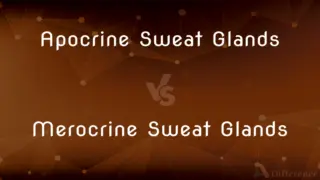Bluish vs. Greenish — What's the Difference?
By Urooj Arif & Maham Liaqat — Updated on May 2, 2024
Bluish refers to a slight blue tint or hue in coloration, suggesting the presence of blue, while greenish indicates a similar tint or hue of green.

Difference Between Bluish and Greenish
Table of Contents
ADVERTISEMENT
Key Differences
Bluish is used to describe objects or substances that have a subtle blue tone, often implying a mixture or dilution with other colors. On the other hand, greenish refers to an object or substance that appears slightly green, which can be due to blending green with other colors.
In terms of perception, bluish hues are generally cooler and can evoke feelings of calm and serenity, reflecting the properties of blue as a color. Conversely, greenish tones, which relate closely to nature, often evoke feelings of freshness, growth, and vitality.
In artistic contexts, adding a bluish tint can create depth or coolness in imagery, used effectively in shadows or depicting night scenes. Greenish tints, however, are frequently used to depict vegetation, springtime scenes, or to add a naturalistic feel to artworks.
Bluish colors can often be associated with elements like water or sky due to their natural blue coloration. Greenish colors are more likely to be associated with plants or grass, tying closely to their common appearances in nature.
The use of bluish versus greenish can significantly affect the mood and perception of a space or design, with bluish tones typically leading to a more subdued, cooler feel, whereas greenish tones might create a livelier, more organic atmosphere.
ADVERTISEMENT
Comparison Chart
Definition
Having a slight blue tint or hue
Having a slight green tint or hue
Emotional Association
Calm, serenity
Freshness, growth
Artistic Use
Depth in shadows, coolness in scenes
Naturalistic scenes, vegetation
Natural Association
Water, sky
Plants, grass
Effect on Mood
Subdued, cool atmosphere
Lively, organic atmosphere
Compare with Definitions
Bluish
Cool and subtle.
Her bluish dress matched the cool, serene atmosphere of the evening.
Greenish
Naturalistic influence.
He added a greenish tint to the painting to make it feel more alive with nature.
Bluish
Reflective of calm.
The bluish tones in the room created a calming effect.
Greenish
Associated with natural elements.
The greenish hue of the leaves brought vibrancy to the garden scene.
Bluish
Slight blue tint.
The bluish light of dawn gave everything a quiet, mysterious look.
Greenish
Slight green tint.
The greenish water in the pond reflected the lush surroundings.
Bluish
Indicative of depth.
The artist used a bluish hue to deepen the perspective in his painting.
Greenish
Fresh and subtle.
The walls were painted a light greenish color to evoke a sense of spring.
Bluish
Associated with cool elements.
The bluish shadows on the snow enhanced the cold feel of the landscape.
Greenish
Evocative of growth.
The greenish buds on the trees were a sign of the coming renewal.
Bluish
Somewhat blue.
Greenish
Somewhat green.
Bluish
Having a tint or hue similar to the colour blue.
Greenish
Somewhat green.
Bluish
(figuratively) Somewhat depressed; sad.
Greenish
Somewhat green; having a tinge of green; as, a greenish yellow.
Bluish
Somewhat blue; as, bluish veins.
Greenish
Similar to the color of fresh grass;
A green tree
Green fields
Green paint
Bluish
Having a color similar to that of a clear unclouded sky;
October's bright blue weather
A blue flame
Blue haze of tobacco smoke
Common Curiosities
What emotions are typically evoked by bluish colors?
Bluish colors often evoke feelings of calm, serenity, and sometimes sadness, depending on the context and depth of the hue.
Can greenish and bluish hues appear together effectively in design?
Yes, bluish and greenish hues can complement each other well, especially in designs inspired by natural water and vegetation scenes, providing a calming and refreshing aesthetic.
How do lighting conditions affect the perception of bluish and greenish tints?
Lighting conditions can greatly affect how bluish and greenish tints are perceived; natural light can enhance their freshness and depth, while artificial light may alter how these tints are viewed.
What settings are ideal for using greenish colors?
Greenish colors are ideal for spaces intended to reflect growth, vitality, or a connection to nature, such as spas, gardens, or health-related environments.
How does the tint of bluish compare to pure blue?
Bluish tints are less intense and more diluted than pure blue, often mixed with other colors to achieve a subtler effect.
How do artists utilize bluish tints to convey mood in paintings?
Artists utilize bluish tints to convey mood by enhancing the coolness or depth of a scene, often using it to depict night scenes, winter, or water elements.
What are some practical applications of greenish tints in commercial spaces?
In commercial spaces, greenish tints can be used to promote an atmosphere of growth and vitality, suitable for businesses focusing on health, wellness, or environmental consciousness.
Are there any cultural significances associated with bluish and greenish colors?
Culturally, bluish tones are often associated with stability and trust, commonly used in corporate designs, while greenish tones might be linked to health, environment, and prosperity, often used in branding for natural products.
What is the psychological impact of using greenish hues in living spaces?
Greenish hues in living spaces can psychologically create a restorative, soothing environment, often recommended for areas requiring tranquility and rejuvenation.
How do seasonal changes affect the use of bluish and greenish colors in fashion and decor?
Seasonal changes greatly influence the use of bluish and greenish colors; bluish tones might be favored in cooler months or styles, while greenish tones could be more prominent in spring and summer collections, reflecting the seasonal shifts in nature.
Share Your Discovery

Previous Comparison
Formica vs. Melamine
Next Comparison
Urology vs. NeurologistAuthor Spotlight
Written by
Urooj ArifUrooj is a skilled content writer at Ask Difference, known for her exceptional ability to simplify complex topics into engaging and informative content. With a passion for research and a flair for clear, concise writing, she consistently delivers articles that resonate with our diverse audience.
Co-written by
Maham Liaqat













































